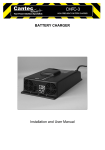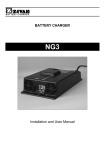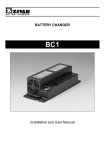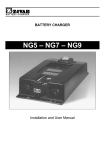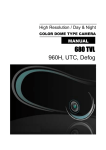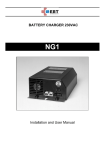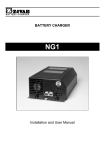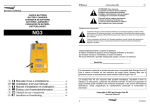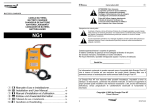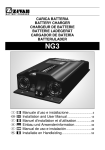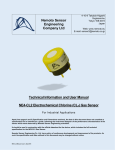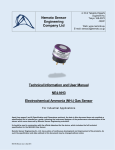Download Zivan NG7 Instruction manual
Transcript
NG5-7-9 CAN Bus Interface English ATTENTION: To reduce the risk of electric shock, do not remove cover. Refer servicing to qualified service personnel. Disconnect the mains supply before connecting or disconnecting the links to the battery. Read the Instruction Manual carefully before use. Verify that the selected charge curve is suitable for the type of battery You have to re-charge. Explanation of Graphical Symbols: The lightning flash with arrowhead symbol, within an equilateral triangle, is intended to alert the user to the presence of uninsulated "dangerous voltage" within the equipment's enclosure; that may be of sufficient magnitude to constitute a risk of electric shock to persons. The exclamation point within an equilateral triangle is intended to alert the user to the presence of important operating and maintenance (servicing) instructions in the literature accompanying the equipment. This product is covered by warranty. The relative warranty certificate is attached to the Instructions Manual. If the Manual is not provided with this certificate, please ask your retailer for a copy. For further references, please write the serial number in the proper space: Serial No. Information contained in this Manual relates to ZIVAN S.r.l. property which reserves the right to supply for the exclusive use of customers. No other use is allowed without a written authorization supplied by ZIVAN S.r.l. ______________________________________________________________________________________________________ |ZIVAN S.r.l. will be not responsible for inaccuracies contained in this manual due to print or translation errors. ZIVAN S.r.l. has the right to make changes or improvements, also for the user interest, without prejudicing the essential characteristic of operation and safety. ____________ Installation and safety instructions Battery charger NG5-7-9 plus has been designed to provide safety and reliable. It is necessary to observe the following precautions in order to avoid damage to persons and to the battery charger: • Read the installation instructions contained in this Manual carefully. For further information put the Manual in a proper place. • Fix the battery charger to a stable surface through the appropriate holes inserted on the fixing flanges. In case of installation on a vehicle it is advisable to use anti-vibration supports. • Preferably the charger should be installed in the vertical position with the fan facing up. The horizontal installation is allowed. Never install in the vertical position with the fan facing down. • Ensure all ventilation ports are not obstructed, to avoid the overheating. Do not put the battery charger near heat sources. Make sure that free space around the battery charger is sufficient to provide adequate ventilation and an easy access to cables sockets. • Protect the battery charger from ingress of water. Do not pour liquids inside the case. • Verify that the available supply voltage corresponds to the voltage that is stated on the battery charger name plate. In case of doubt, consult a retailer or local Electric Supply Authority. • As protection device in the input of the battery charger You can both use a switch of AC class, but it is warmly recommended to use one of A class or even better one of B class. • For safety and electromagnetic compatibility, the battery charger has a 3-prong plug as a safety feature, and it will only fit into an earthed outlet. If you can´t plug it in, chances are you have an older, non-earthed outlet; contact an electrician to have the outlet replaced. Do not use an adapter to defeat the grounding. • To avoid damaging the power cord, do not put anything on it or place it where it will be walked on. If the cord becomes damaged or frayed, replace it immediately. • If you are using an extension cord or power strip, make sure that the total of the amperes required by all the equipment on the extension is less than the extension's rating. • Disconnect the mains supply (turn off the switch) before connecting or disconnecting the links to the battery. • To recharge Lead Acid batteries: WARNING: Explosive Gas - Avoid flames and sparks. The battery must be positioned in a correctly cooled place. • Do not use to charge batteries installed on board of thermal engine cars. ' • Avoid recharging of non-rechargeable batteries. • Verify that the nominal voltage of the battery to be re-charged corresponds to the voltage stated on the battery charger name plate. • Verify that the selected charging curve is suitable for the type of battery to be re-charged, in case of doubt, consult Your retailer. ZIVAN S.r.l. will not accept any responsibility in case of mistaken choice of the charging curve that may cause irreversible damage to the battery. • In order to avoid voltage drop, thereby assuring 100% charge at the battery, the output cables must be as short as possible, and the diameter must be adequate for the output current. • Do not try to service the battery charger yourself. Opening the cover may expose you to shocks or other hazards. • If the battery charger does not work correctly or if it has been damaged, unplugged it immediately from the supply socket and from the battery socket and contact a retailer. D01570-02 9 NG5-7-9 CAN Bus Interface Visualization Digital Instrument During the first minute after starting, on the digital instrument it will be displayed the value of the voltage drop on the output cables. cable To set the compensation value made by the charger to balance the voltage drop on the cables please follow the procedure "Compensation ation setting of the voltage drop on output cables. After one minute from the starting the digital instrument will display the string of the following parameters: • • • • • BATTERY VOLTAGE (two-tone red upper led). CURRENT provided by the charger (two-tone red lower led). TIME in hours lacking to the end of charge (two-tone tone green upper led). Ah supplied (two-tone green lower led). CONNECTED GADGETS (no two-tone led on - only on a MASTER battery charge). By pressing once the MODE button, the parameters' sequence is blocked and it will be kept the last value displayed. By pressing again on the MODE button the sequence of parameters restarts. Compensation setting of the voltage drop on output cables. During the lapse of time along which the digital instrument displays displays the voltage drop on the output cables (first minute after starting) it is recommended to follow the below-mentioned below procedure: v 1. Gauge the voltage drop at the ends of the output bars of the battery charger (close to the cover). 2. Gauge the voltage on the battery poles. 3. Make the difference between the two values to get the voltage drop compensate. 4. Press shortly the MODE button (ROLL) until reaching the nearest voltage value to the desired one: it is possible to ROLL parameters between 0,0V e 1,5V with steps of 0,1V. 5. Press long the MODE button (ENTER) to confirm. confirm Ready Light Charging status and current pha PHASE Phase 1 Phase 2 Phase 3 Phase 4 Phase5-Phase6 Phase6 End of charge RED LED On On with short flashing On On with short flashing spegnimenti Off Off GREEN LED Off Off On with short flashing On with short flashing On with short flashing On When using the remote visualisation through two-tone two LED (AUX F - Pin 1 e 2), the following signals are valid: PHASE RED GREEN Phase 1 On Off Phase 2 On with short quenching Off Phase 3 Off Off Phases 4-5-6 6 & End charge Off On S/S or alarm Off Off IMPORTANT: according to the charging curve used maybe some phases are lacking. YELLOW Off Off On Off Off D01570-02 10 NG5-7-9 CAN Bus Interface Charging curve selection You can press the MODE button according two modalities: 1. Long pressure (at least 1 second): along the battery charger setting it means ENTER 2. Short pressure (less than 1 second): along the battery charger setting it means ROLL Setting: 1. 2. While pressing the MODE button light on the equipment. ROLL: select the branch type: • • • 3. 0 corresponds to a MASTER unit charger (connected with one or more SLAVES units). from 1 to 8 it gives the ID of the SLAVE (used together to a MASTER). 9 identifies a STAND-ALONE charger (used as a single unit). ENTER: branch type confirmation. Next selection is choose the Battery type (Lead acid type corresponds to BA1 otherwise Gel corresponds to BA2). ENTER: Battery type confirmation: next level is to select the Charging curve. ROLL: select the desired Charging curve. Availability is on 4 charging curves: a. CU1: lUla curve; b. CU2: IUIU0 curve; c. CU3: power supply; d. CU4: programmable curve (eg. desulphation). ENTER: Charging curve confirmation: now select the Capacity. ROLL: Capacity selection. Starting point is a nominal value and by the ROLL you can select a value included between 50% and 140% of the nominal in steps of 10%. On the display it is shown the last capacity selected. ENTER: Capacity confirmation: then you can select the Recharging time (in hours). ROLL: Recharging time confirmed . Starting from a suggested Recharging time (according to the capacity chosen at the previous step) this time can only be increased up to 20 hours max. ENTER: Recharging time confirmation: the battery charger goes to a stand-by modality waiting that the output cables being connected to the battery binding-clamps (if connections have been done already before starting the setting, once arrived at point 10 the charger immediately starts). 4. 5. 6. 7. 8. 9. 10. Warning: if some trouble or mistake may occur along setting procedure, switch off the battery charger by the rotary ON-OFF switch, then switch oh again by keeping pressed the MODE button and restart setting operation from the beginning. Alarms When an alarm situation stopping the charge occurs, the display shows one of the information below according failure detected: <A> <alarm code identified with a 2 digits code> Alarm table list here following: ALARM TYPE LOGIC FAILURE #1 CAN BUS KO WATCHDOG HIGH TEMPERATURE BATTERY MISSING PHASE OVERCURRENT HIGH TEMPERATURE MISMATCH VOLTAGE TIMEOUT OVER DISCHARGE DEEP DISCHARGE BATTERY DISCONNECTED PUMP MISTAKE TH. SENSOR KO CODE A01 A02 A03 A05 A06 A07 A08 A09 A10 A11 A12 A13 A14 A15 Notes: A05: A11: A12: A15: DESCRIPTION Trouble on current detection Trouble on CAN communication Loqic board mis-workinq Battery over temperature (>55°C) Phase lacking Over current Battery charter high temperature Internal failure End of Phase 1 due to timeout Over discharged Battery Deeply discharged Battery Battery disconnection white charging . Air pump mis-working Thermal sensor failure STOP YES NO YES YES YES YES YES YES YES NO NO YES NO NO The charge restarts once the battery temperature reaches a value lower than 50 °C. Notice on the battery status. By pressing the MODE button, a desulphation phase start followed then by the standard charge. Notice on the battery status. The standard charge is starting anyway With the thermal sensor out of order the battery charger behaves as if it was not equipped with by showing the A15 code on the display. Each alarm except A02 and A13, gives also a 30' lasting audible alarm. D01570-02 11 NG5-7-9 CAN Bus Interface English Auxiliary contacts Connector C D E F Section Function AUX1 Mains Presence AUX2 End of charge or Trickle Phase Description (Unless otherwise stated)the equipment is switched When on, the contact Normally Open (NO) CLOSES and instead the contact Normally Closed (NC) OPENS. When the Stop Phase or the No Stop Phase is reached, the contact Normally Open (NO) CLOSES and instead the contact Normally Closed (NC) OPENS. PinN0 1-2 1 2 3 4 1 2 3 4 5 6 1 2 3 4 5 6 7 8 Description Start/Stop Hardware -BATT. Thermal sensor contact Temperature sensor Temperature sensor (- BATT) Air Pump contact -BATT Air Pump sensor NC normally closed (AUX 1) NO normally open (AUX 1) COM common (AUX 1) LED R (remote visualisation) LED V (remote visualisation) -BATT -BATT NC normally closed COM common2) NC normally open Further contact for digital input Nominal current/Max instant current A 10/15 Nominal voltage/ Max voltage commutable Vac 250/250 Nominal load in AC1 VA 2500 Nominal load in AC15 (230Vac) VA 500 Single phase engine capacity (230 Vac) Kw 0.37 Break power in DC1:30/110/220 VA 10/0.3/0.12 Minimum mW commutable charge (V/mA) 500 (5/100) Mechanical length AC/DC cycles -/10x106 Electrical duration with nominal charge in A1 cycles 100X103 Isolation according EN 61810-1 2nd edition 2.5 kV/2 Isolation between coil and contacts (1.2/50 us) kV 4 Dielectric rigidness between open contacts Vac 1000 ADDITIONAL FEATURES WITH AIR PUMP Standard Version The Air Pump technology generates a re-mix of the acid inside the battery by a constant delivery of air pumping. The battery charger controls the air pump by an auxiliary contact (generally AUX1). An air injection cycle along all the charging period is held as per requirements of the battery specifications. Pressure sensor version Further to the characteristics of the standard version it is also available an electronic circuit equipped with an air pressure sensor. At the beginning of the charging process, the sensor verifies that the pressure in the circuit is included in a definite window between a minimum and a maximum value (look at the following table). When an anomaly occurs the battery charger will modify the charging factor by effecting a charge without detecting and controlling the Air Pump Technical Features Description Symbol Power absorbed by the Air Pump PaD input fuse Maximal dimensions axbxc Weight . Air Delivery* Q Available pressure range Ap * To know the effective air delivery please refer to the plate 12 Test Condition Air Pump controlled Equipment interns Without connecting cables Without connectinq cables Air Pump controlled Starting charging point Value and/or Range 90 1,6 657x267x226 17,5 4:13 50 : 250 D01570-02 Unit W A mm kg l/min mbar English NG5-7-9 CAN Bus Interface TECHNICAL FEATURES Ta =25°C unless otherwise specified Mains side Description Supply Voltaqe Three-phase Frequency Symbol Vin f Test Condition lfmax P = Pmax Inrush Current Power Factor Absorbed Minimum Power COS phi Pinmin Vin=400Veff P = Pmax End of charge Absorbed Maximum Power Pinmax P = Pmax Absorbed Maximum Current per phase Value and/or Range 400 + 15% 50 + 60 10(NG5) 14(NG7) 18(NG9) <2,35 0,72 <10 5 (NG5) 7 (NG7) 9( NG9) Unit Veff Hz Aeff A W kW * Maximum value per model. For the effective current absorption please refer to the charger´s identification label. Battery side Description Output current Maximum output current Output current ripple Absorbed current Output voltage Constant output voltage Thermal compensation of output voltaqe Operating range of Temperature Sensor Output voltaqe ripple Maximum power supplied Output capacity Symbol I I1 >a U U1 dU1/dT AT p max Test Condition Phase 2 Value and/or Range See curve See curve < 5% <0,5 See curve See curve Phase 2 -5 from -20 to +50 U-U1 <1% 4800 (NG5) 6300 (NG7) 7700 (NG9) Depend on the model (>0,2) mF Phase 1 l = I1 Equipment turned off U = U1,I=I1 C - Unit A mA V mV/CC-cell) <C W General Description Operating range of temperature Maximum relative humidity Switching frequency Efficiency Maximum size Weight Enclosure class Symbol Test Condition Value and/or Range Unit AT RH fc eta axbxc At each operation condition Without connectinq cable from -20 to +50 90% 20 ±5% > 87% 550x270x120 9 IP20 °C kHz mm kg Protection and Safety Description Symbol Value and/or Range Unit Mains to Battery side 1250 VAC Insulation Mains side to Earth 500 VDC Insulation Battery side to Earth 500 VDC 'L Supplied equipment mA F1-F2-F3 Inside the equipment F5 Inside the equipment <7 20 (NG5) 20 (NG7) 25 (NG9) about 1,2xI1 - Equipment turn on 1,5 V/cell Urn Phase 3 (lUla - lUIUo) At the connection to the Battery See curve Protection provided by fuse F5 V Ta=55<C 100 Insulation Leakage current (EMC Filter) Input fuses Output fuse Minimum output voltage of operation (Battery Detector) Maximum output voltage Reverse output polarity Thermal protection of semiconductors (Temperature of Thermal Alarm) Safety Requirements (Rules) EMC Requirements (Rules) D01570-02 Test Condition A A EN60335-1,EN60335-2-29 EN55011, EN61000-4-2, EN61000-4-4 13





